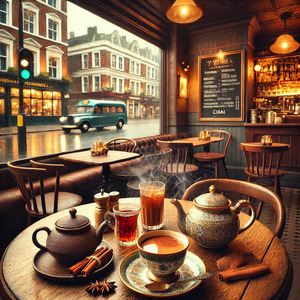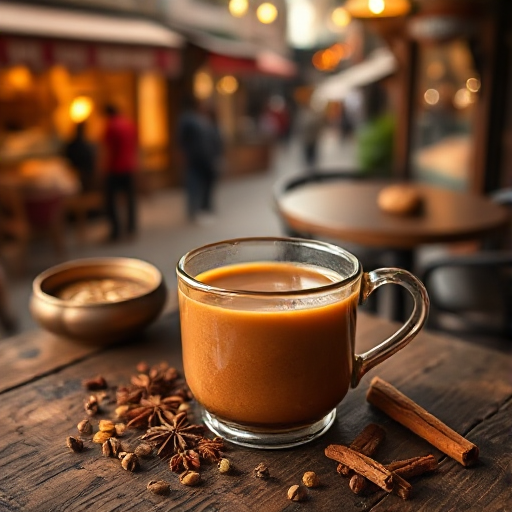Chai (Tea) is a popular drink enjoyed all over the world. It’s simple, fragrant, and filled with spices and tradition, making it a part of daily life in many cultures. Whether being consumed in an Indian home, a bustling café in London, or a cozy kitchen in New York, the unmistakable warmth and comforting flavor of chai is impossible to ignore. But how did this iconic drink, a mix of tea, milk, and spices, become a global phenomenon that crosses borders but also spans centuries of history? Let us now follow the history of chai from the roots of origin till its journey into the magic in irresistible taste, changing from a comfort drink to be adored by everyone all over the world.
Origins of Chai: History and Cultural Legacy
“ Chai ” simply means “tea” in Hindi, but despite the fact that brewing tea as a practice dates back thousands of years, this version of it which we recognize as chai today comes with a rather specific history from India.
Modern Form
The concept of chai, as-we-know-it-today-emerged during the British colonial era with the brewing of tea, with milk, sugar, and spices that include cardamom, cinnamon, ginger, cloves, and black pepper. Tea plantations were introduced to India by the Britishers in the 19th century. As a commodity, tea became an emblem of colonial rule; yet, the people of the region took possession of it right away and began adding local spices to it to create a savory but functional brew. Although its etymology is suspect, some historians think that chai, in its spiced version, was actually an adaptation of Ayurvedic principles that have, for thousands of years, touted the medicinal benefits of various spices. Most likely, the health-giving properties of its spices, like ginger and cardamom, made the tea a medical prescription to cure many ailments, rather than simply a daily shot of caffeine.
Why Is Chai So Addictive?
There’s a flavour of chai greater than the notion of taste alone. That’s the feeling. Even to action itself of brewing this chai is celebratory, almost sensory: warm comfort of cinnamon-cardamom-steam rising towards the nose before it has got a chance of reaching the cup-a first sip through warmth.
The magic of chai lies in its balance: sugar or jaggery balances spiciness from the aromatics and still a rich, grounding flavor from the tea base. The milking smoothes out the acidity of the spices, making it silky smooth across the tongue. And every ingredient puts together an experience that is both comforting and invigorating.
But beyond its ingredients, chai unites in a deeply emotive way. All too often it is the pot of choice to bring family and friends together again, not to mention the more casual gathering of business in a neighborhood coffee shop. With a warmth for body and soul, chai can tie people together while making this pot a far-from-a-drink practice-a social ceremony.
Beyond India: The Global Love Affair of Chai
Chai, born in India, has emerged as a staple of every city across the world-from London streets to American cafes. Its popularity as a drink around the world has been phenomenal, and the journey from an Indian traditional brew to this global phenomenon testifies to the versatility and appeal of chai.
1. Chai in India: The Beat of Daily Life
Chai is more than a drink; it is life in India.
The Chaiwalas of the nation sell their brew from small carts on the streets of India, with kettles bubbling to the familiar whiff of ginger and cardamom. People of all ages enjoy it at all hours of the day and are often served with biscuits, samosas, or pakoras. There is never a meeting, celebration, or family gathering which goes without a round of chai. Chai is one of those things that have found a place in the heart of each Indian irrespective of his class, age, or region, clay cups, or the sturdiest glass tumbler.
2. West’s Love Affair with Chai:In America
Chai has discovered a new life in the “chai latte” – combining Indian traditional tea culture with the coffee culture of America.

In fact, chains of coffee shop around the country have recently come to blended spiced chai concentrate over ice with steamed milk in “chai lattes.” Chai has also been enjoyed under this form, although it looks almost extraterrestrial compared to its traditional version; it has created a whole new genre of tea consumption into the beverage culture. Now a staple trend in cafes and mostly ordered over coffee by their clients, humble roadside drink became.
3. Chai in the UK: A New Twist on Tea Time
In Britain, the land of its own strong tea culture, chai has found a warm embrace, especially in the larger urban centers like London.

While British tea had long revolved around the central theme of black tea with milk, chai injected a refreshing dose of spice into this mix. Chai bars and chai-spiced products proliferated throughout the city, providing a spiced variation on British tea. Whether a spiced-infused muffin or a spiced brew in a quiet café, chai has become a staple to the Brit’s repertoire of drinking tea.
4. Chai in Australia: A Cultural Mélange
The second country swept by the chai phenomenon was Australia, a land of bright cafés. Within a relatively short period, most Australian coffee shops adopted the “Chai Latte” as an adjunct to Australian breakfast fare or as an afternoon pick-me-up. The flavor of spices with milk was just as irresistible to Australians as it was to Americans and paved the way for a new cultural tea tradition brew.
5. Chai in the Middle East and Beyond

Chai has very close connections to tradition and hospitality in Turkey and Iran. However, while in the latter the brew is taken black, usually without the multiple spice mix commonly added to the Indian variety, they are also, amazingly fragrant, full-bodied, and a true comfort brew. Spiced tea versions have been around for a long time in the Middle East as well, and are similar to the rich flavor of chai; with the addition of saffron or rose water to create their special regional versions.
What makes chai so universally loved?
Perhaps it is the sense of ritual that accompanies it. India is probably a place where the act of making chai might often be bestowed with a deliberate process, almost as if it became an act of mindfulness there. It offers another warm and relaxing alternative in the West when it comes to coffee. The communal aspect of chai makes it a beverage that symbolizes connection and hospitality: whether to share with a friend, enjoy quietly alone, or offer as a guest receives. The second reason for its popularity is the various chai. One loved is the traditional one, but the creative ones have appeared. Ice chai latte became one of the most liked sweets; flavors reminiscent of chai filled in even some cocktails with a splash of chai, spilling out from the cafes and restaurants across the world. But still, be it your penchant for hot or cold chai, either with spices or sugars; it is sure an enormous comfort drink bringing joy every sip.
Chai Around the World: A Global Phenomenon
- India: Millions of people drink this hot, spicy milky tea every day from street-side chaiwalas.
- United States: Chai latte becomes the symbol of café culture with fashionable baked goods.
- United Kingdom: This is increasingly consumed as a spicier alternative to traditional English breakfast tea.
- Australia: Chai latte has emerged as an essential order in coffee shops in Australia at any time of the day.
- Middle East: Chai or spiced tea is a traditional drink, normally served with some sweetmeat.
- Turkey & Iran: Chai is used as a gesture of hospitality and has some local variations.
Chai Recipes to Prepare in Home
If you enjoy making chai at home, here are some recipes that you can simply prepare in your kitchen for this international drink.
1. Masala Chai Recipe
Ingredients:
1 cup water
1 cup milk (or non-dairy milk)
2 tbsp loose black tea leaves or 2 tea bags
2-3 green cardamom pods, crushed
1 small cinnamon stick
2-3 cloves
1-2 slices of fresh ginger
1-2 tsp sugar or jaggery or to taste
How to prepare:
Boil water in a small saucepan. Add crushed cardamom, cinnamon stick, cloves, and ginger slices. Let it simmer for 2-3 minutes. Then add black tea leaves and simmer again for 2 minutes. Add milk and sugar or jaggery and simmer for 3-5 minutes. Strain into a cup and serve hot. Enjoy!
2. Chai Hot Chocolate
Ingredients
1 cup of milk or other preferred milk
1 tbsp of unsweetened cocoa powder
1-2 teaspoons sugar
1/4 tsp ground cinnamon
Pinch ground ginger
1-2 cardamom pods, crushed
1 small piece of dark chocolate (optional)
How to prepare:
Heat milk in a saucepan over medium heat.
Add cocoa powder, sugar, cinnamon, ginger, and cardamom. Stir until smooth.
Add the piece of dark chocolate (optional) and stir until melted.
Pour into a mug and enjoy this spicy, comforting chocolate drink!
3. Vegan Chai Latte
Ingredients:
1 cup brewed masala chai (using almond or oat milk)
1/2 cup almond milk (or your preferred non-dairy milk)
1-2 teaspoons maple syrup
How to prepare:
Steep your chai with non-dairy milk (see traditional recipe but substitute with almond or oat milk).
Add maple syrup to taste once brewed.
Pour into a mug and top with more steamed non-dairy milk.
Enjoy your creamy, comforting vegan chai latte!
4.Iced Chai Latte
Ingredients:
1 cup brewed masala chai (above recipe)
1/2 cup milk (or your preferred non-dairy milk)
1-2 tsp sweetener (sugar, maple syrup, honey)
Ice cubes
How to prepare:
Brew your chai and let it cool to room temperature.
Fill a glass with ice cubes
Add cooled chai, milk, and sweetener, stir
Sip and enjoy your iced chai latte
Chai: The Drink that Warms the World
Chai is more than just a beverage—it is a unifier, a bridge between cultures, and a symbol of comfort and togetherness. From its humble beginnings in India to its global embrace, chai’s journey is one of connection. Whether it’s sipped as part of a morning routine, shared with friends, or enjoyed in a café halfway around the world, chai has earned its place as a drink that transcends borders and warms the hearts of millions.
Whether in New York, Bombay, or in some quiet café tucked away in the streets of some European town, when you sip chai the next time, know that you’re sharing in a centuries-old tradition and in that moment, the world feels just a little bit smaller, a little bit warmer.



